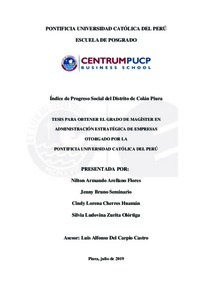| dc.contributor.advisor | D´Alessio Ipinza, Fernando Antonio | |
| dc.contributor.author | Arellano Flores, Nilton Armando | |
| dc.contributor.author | Bruno Seminario, Jenny | |
| dc.contributor.author | Cherres Huamán, Cindy Lorena | |
| dc.contributor.author | Zurita Olórtiga, Silvia Ludovina | |
| dc.date.accessioned | 2019-10-06T18:51:44Z | |
| dc.date.available | 2019-10-06T18:51:44Z | |
| dc.date.created | 2019-07 | |
| dc.date.issued | 2019-10-06 | |
| dc.identifier.uri | http://hdl.handle.net/20.500.12404/15109 | |
| dc.description.abstract | Medir el progreso social de las naciones es un tema primordial para los países,
regiones y ciudades. Esta métrica social que tiene por objetivo medir la calidad de vida de las
personas más allá de los resultados económicos se convierte en una herramienta para orientar
la inversión social e identificar aquellos aspectos que deben ser mejorados. Perú no escapa de
esta agenda mundial por ello en el año 2017, se presentó la segunda publicación del IPS para
las regiones de Perú, a través de una alianza entre CENTRUM PUCP, Fundación Avina,
Deloitte, y el Social Progress Imperative. La región Moquegua se ubicó como líder con
67.47 puntos de 100, seguida por Lima Metropolitana e Ica con 65.63 y 65.46 puntos
respectivamente, mientras que la región Piura se ubicó en la posición 14 con 58.40 puntos.
La presente investigación tiene por objetivo calcular el Índice de Progreso Social para
el distrito de Colán ubicado en la provincia de Paita en la región Piura, basándose en el
modelo presentado por el Social Progress Imperative. Para llevar a cabo la investigación se
segmentó al distrito en dos zonas y con información de fuente primaria (recogida a través de
una encuesta de 54 preguntas en una muestra de 354 viviendas) y de fuente secundaria (base
de datos confiables) construyendo 53 indicadores; finalmente el análisis estadístico permitió
evaluar y considerar 34 indicadores que explican y determinan el cálculo del IPS.
El cálculo del Índice de Progreso Social para el distrito de Colán, obtuvo un resultado
de 51.93 puntos de 100 ubicándolo en un nivel “Bajo”, de acuerdo a las dimensiones el
mayor puntaje se dio en la dimensión de Necesidades Humanas Básicas, seguido de
Fundamentos del Bienestar y por último Oportunidades, estos resultados tanto del IPS como
de las tres dimensiones se encuentran por debajo de la región Piura, realidad que refleja un
bajo nivel de progreso social y consecuentemente revela alertas que deben ser atendidas con
urgencia con el fin de mejorar la calidad de vida de los habitantes del distrito de Colán. | es_ES |
| dc.description.abstract | Measuring national social progress is a topic of primary interest to all the countries,
region and cities. The objective of this metric is to measure the quality of life of people that go
far beyond economic performance. Social progress is a tool to guide social investment and to
identify significant points for improvements. The Peru case is concerned by this situation and
by the global agenda, this it was presented the second publication of IPS aimed to the regions
of Peru in 2017, led by an alliance by CENTRUM PUCP, Fundación Avina, Deloitte, and the
Social Progress Imperative. The Moquegua Region is recognized as leader scoring 67.47 of
100, followed by Metropolitan Lima and Ica reaching 65.63 and 65.46 respectively, meanwhile
Piura region reached the position 14 scoring 58.40 points.
The objective of this study is to calculate the Colan District Social Progress Indicator,
located in Paita province and Piura region, based on the model of the Social Progress
Imperative. To carry out the necessary research the Colan District was accurately segmented
into two areas and the information came from primary source (results of a 54-question survey
applied to 354 responded-household) and the secondary source (reliable databases), it was built
53 indicators; finally the statistical analysis allowed evaluate and consider 34 indicators that
explain and determine the final result of the IPS.
The calculation of the indicator of the Colan District Social Progress Indicator,
produced a score of 51.93 points of 100, securing a “low” position, according of the
dimensions the highest score was for Basic Human Needs dimension, followed for
Foundations for Well-being and finally Opportunities dimension, this 3-dimension findings
as well as IPS’ are under Piura region indicators, situation that reflect a poor level of social
progress and consecutively raise the alarm in order to address these issues urgently to
improve the quality of life of the people form Colan district. | es_ES |
| dc.language.iso | spa | es_ES |
| dc.publisher | Pontificia Universidad Católica del Perú | es_ES |
| dc.rights | info:eu-repo/semantics/openAccess | es_ES |
| dc.rights.uri | http://creativecommons.org/licenses/by-nc-nd/2.5/pe/ | * |
| dc.subject | Indicadores económicos--Perú--Colán (Piura : Provincia) | es_ES |
| dc.subject | Indicadores económicos--Perú--Colán (Piura : Provincia) | es_ES |
| dc.subject | Investigación cuantitativa | es_ES |
| dc.title | Índice de progreso social del distrito de Colán Piura | es_ES |
| dc.type | info:eu-repo/semantics/masterThesis | es_ES |
| thesis.degree.name | Magíster en Administración Estratégica de Empresas | es_ES |
| thesis.degree.level | Maestría | es_ES |
| thesis.degree.grantor | Pontificia Universidad Católica del Perú. CENTRUM | es_ES |
| thesis.degree.discipline | Administración Estratégica de Empresas | es_ES |
| renati.advisor.dni | 41319855 | |
| renati.author.dni | 41868470 | |
| renati.author.dni | 02824865 | |
| renati.author.dni | 43530037 | |
| renati.author.dni | 41878371 | |
| renati.discipline | 413307 | es_ES |
| renati.level | https://purl.org/pe-repo/renati/level#maestro | es_ES |
| renati.type | https://purl.org/pe-repo/renati/type#tesis | es_ES |
| dc.publisher.country | PE | es_ES |
| dc.subject.ocde | https://purl.org/pe-repo/ocde/ford#5.02.04 | es_ES |






